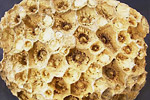Paleontology and geologyThe Precambrian and Paleozoic: In West Virginia there are no Precambrian rocks found on the surface. In contrast, Paleozoic rocks are well represented. A shallow sea inhabited by trilobites, marine worms, colonies of graptolites, and abundant stromatolites covered West Virginia during the Cambrian. This was followed in the Ordovician by an episode of mountain building far to the east of the state. This orogeny produced a chain of mountains that subsequently eroded, so that by the Late Silurian, the land had worn down to near sea level. Limy sediments were deposited in the shallow nearshore settings during this time, and straight-shelled nautiloids and ostracodes were common. A second orogeny occurred east of the state during the Late Devonian. This uplift and the subsequent erosion produced sediments thousands of feet thick that gradually filled the shallow waters covering the state and left much of it above sea level. Erosion and deposition of vast amounts of sediment continued into the Early Carboniferous before a shallow limy sea again returned to cover West Virginia. The Paleozoic ended with a third orogeny, as the former continents of Gondwana and Laurentia collided to form the Appalachian Mountains. Large rivers flowed from the rising mountains and deposited sediments in vast deltas. The wet tropical environment produced extensive coal-forming swamps in these river deposits. Amphibians, ferns, scale trees (Lycophyta), and horsetail rushes flourished in the boggy conditions.
The Mesozoic: Mesozoic rocks are not present in West Virginia, thus we have no fossil record for the Triassic, Jurassic, or Cretaceous.
The Cenozoic: There are no Tertiary rocks present in West Virginia and few Quaternary deposits, as West Virginia was south and east of the ice sheets in Pennsylvania and Ohio during this time interval. Fossils of mastodons, mammoths, and ground sloths are known only from Quaternary cave deposits. |

